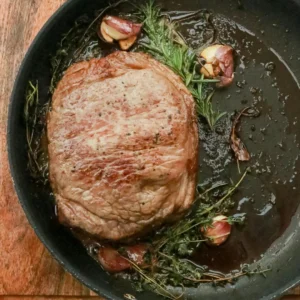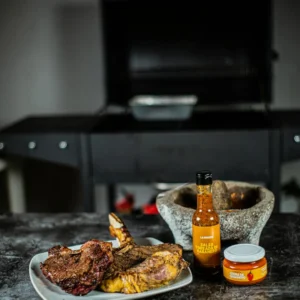Medium Heat Steak: A New Way to Sear
For generations, searing steak at scorching temperatures was the golden rule – until the medium heat steak method emerged. But what if the route to a beautifully caramelised exterior and juicy interior didn’t require blistering heat? A slower, more considered approach may just yield results that are both flavourful and forgiving.
Rethinking the Traditional Sear
Conventional steak wisdom typically revolves around maximum heat and minimal cooking time. The logic is sound: searing at high temperatures promotes the Maillard reaction – the chemical process responsible for that deeply satisfying crust – while preserving the moisture inside. However, this method leaves little margin for error. Too hot, and you risk a dry, overcooked centre. Not hot enough, and you miss out on the all-important crust.
Emerging as an alternative, and surprisingly effective, is the method of cooking steak over medium heat. It may seem counterintuitive, but the concept has merit. With the right approach, one can achieve a well-browned crust while keeping the internal temperature precisely where it needs to be. This slower method allows for a more even cook throughout, reducing the risk of under- or overcooking, particularly with thicker cuts.
The Science Behind Slower Searing
Understanding why medium heat works begins with appreciating the role of moisture and sugar in the steak. As the meat heats, surface moisture evaporates, allowing the natural sugars and amino acids to break down and brown – this is the Maillard reaction at work. Traditionally, high heat accelerates this process, but given more time, the same chemical magic can occur at a lower temperature.
What’s crucial is not the intensity of the heat, but its consistency. Medium heat provides a controlled environment in which browning still takes place – just more gradually. This offers home cooks greater control, especially if they’re less experienced or working with steaks that demand a gentler touch.
The Practical Guide to Medium-Heat Steak Perfection
 Start With the Right Equipment
Start With the Right Equipment
The success of this method hinges on even heat distribution, and few pans rival cast iron in that regard. A cast iron skillet retains heat exceptionally well, ensuring the cooking temperature remains stable throughout. It also provides a naturally non-stick surface – a bonus when cooking more delicate cuts that benefit from less handling.
If cast iron isn’t available, any heavy-bottomed frying pan with good heat retention will suffice. Avoid thin, lightweight pans that lose heat quickly and create uneven hot spots.
Ideal Temperature and Timing
A target temperature of around 150°C is the sweet spot. This is warm enough to encourage browning but not so hot that the exterior chars before the centre is cooked. Once the pan is at temperature, brush oil onto the steak itself – not the pan – and season it generously with salt and freshly ground black pepper.
Now comes the twist: instead of searing and flipping once, flip the steak frequently. Turning every 30-60 seconds ensures an even crust develops on both sides while maintaining a gentle cook through the centre. This technique mimics the benefits of sous vide – even temperature control and thorough cooking – without requiring specialised equipment.
Resting: The Forgotten Step
No steak is truly finished without a rest. Allowing it to sit undisturbed for five to ten minutes post-cook gives the juices time to redistribute, resulting in a more succulent bite. Skipping this step often leads to a plate full of flavourful juices – and a disappointingly dry steak.
Tips for Enhancing Your Crust: Medium Heat Steak
Choose the Right Cut
Not all steaks are created equal when it comes to this gentler approach. Thinner cuts such as flank or skirt are best suited to high-heat, fast cooking. For the medium-heat technique, opt for steaks with more thickness and marbling – ribeye, sirloin, or even a budget-friendly oyster blade. These can withstand the longer cook time without drying out and develop a satisfying crust in the process.
Go Dry for Better Browning
Moisture is the sworn enemy of browning. A dry steak is a browning steak, so anything that reduces surface moisture will improve your crust. Dry-aged beef naturally has less water content and a deeper, more concentrated flavour – making it ideal for this method.
Alternatively, try dry brining. This involves salting the steak a few hours in advance (or overnight) and leaving it uncovered in the fridge. The salt draws out moisture, which then reabsorbs, seasoning the meat deeply. Right before cooking, pat the steak dry with a paper towel to remove any remaining surface dampness.
Don’t Overcrowd the Pan
One steak at a time is best when using this method. Placing too much meat in the pan can cause the temperature to drop, inhibiting crust formation. If cooking for multiple guests, work in batches or use two pans simultaneously.
When to Use This Technique – And When Not To
 Is medium heat the new gold standard for steak? Not quite – but it’s a valuable method to have in your culinary toolkit.
Is medium heat the new gold standard for steak? Not quite – but it’s a valuable method to have in your culinary toolkit.
This approach is particularly useful when cooking thicker cuts or tougher, more fibrous steaks that benefit from slower cooking. It also suits those looking to avoid the smoke and splatter that comes with high-heat searing.
However, for those chasing the deepest, crispiest crust possible – or when cooking lean, thin steaks – the traditional high-heat method still holds its ground. There’s a time and place for both.
Final Thoughts
Cooking a steak over medium heat won’t win speed records, but it might win over your tastebuds. It offers greater control, less risk, and a surprisingly complex flavour profile. For many, it could be the key to unlocking steak perfection – without the fire alarm going off.